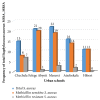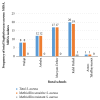Nasal Carriage Rate, Antimicrobial Susceptibility Pattern, and Associated Factors of Staphylococcus aureus with Special Emphasis on MRSA among Urban and Rural Elementary School Children in Gondar, Northwest Ethiopia: A Comparative Cross-Sectional Study
- PMID: 30643649
- PMCID: PMC6311292
- DOI: 10.1155/2018/9364757
Nasal Carriage Rate, Antimicrobial Susceptibility Pattern, and Associated Factors of Staphylococcus aureus with Special Emphasis on MRSA among Urban and Rural Elementary School Children in Gondar, Northwest Ethiopia: A Comparative Cross-Sectional Study
Abstract
Introduction: Staphylococcus aureus is a Gram-positive, catalase-positive, and coagulase-positive bacterial species commonly found on the skin and in the nose of most healthy individuals. The anterior nares of nose are the most frequent carriage sites for S. aureus in both adults and children. Methicillin resistance among S. aureus isolates has steadily increased worldwide.
Objective: The main objective of this study was to determine nasal carriage rate, antimicrobial susceptibility pattern, and associated risk factors of Staphylococcus aureus with special emphasis on MRSA among urban and rural elementary school children in Gondar, Northwest Ethiopia.
Method: A community based comparative cross-sectional study was conducted on 622 urban and rural elementary school children in Gondar from January 1st to March 30th, 2018. Data was collected using a questionnaire and nasal swab samples were collected by sterile cotton tip swab moistened with sterile normal saline. Collected samples were inoculated on mannitol salt agar and incubated aerobically at 37°C for 24 hrs. S. aureus was confirmed by observing colony characteristics and biochemical tests. MRSA was detected using cefoxitin disc by Modified Kirby-Bauer disk diffusion technique. Finally data was entered, cleared, and checked using Epi-info version 7 and exported to SPSS version 20 for analysis. Odds ratio and logistic regression were used for statistical association. P-value ≤ 0.05 at 95% CI was considered for statistical association.
Result: Of the 622 school children, the overall prevalence of S. aureus was 143/622 (23%). Of them, 14/143 (9.79%) were MRSA. The carriage rate in urban schools was 83/622 (13.3%) whereas it was 60/622 (9.6%) in rural schools. The prevalence of MRSA among urban schools, 9.1%, was higher than their urban counterparts, 0.7%. Gentamycin, clindamycin, and ciprofloxacin were the most effective whereas penicillin and tetracycline were resistant. Children's fathers' educational status and number of children in class room were significantly associated with S. aureus but only living in urban of children significantly associated with MRSA.
Conclusion: This study showed high prevalence of S. aureus and MRSA, 143/622 (23%) and 14/143 (9.79%), respectively. So, decolonization of nasal carriers of MRSA and reducing the number of students per classroom should be addressed. Moreover, regular large scale survey should be conducted to assess the burden and intervene accordingly.
Figures


Similar articles
-
Nasopharyngeal carriage, antimicrobial susceptibility patterns, and associated factors of Gram-positive bacteria among children attending the outpatient department at the University of Gondar Comprehensive Specialized Hospital, Northwest Ethiopia.PLoS One. 2024 Aug 28;19(8):e0308017. doi: 10.1371/journal.pone.0308017. eCollection 2024. PLoS One. 2024. PMID: 39197069 Free PMC article.
-
Inducible Clindamycin and Methicillin Resistant Staphylococcus aureus Among Cancer Patients at University of Gondar Compressive Specialized Hospital, Northwest Ethiopia: Carriage Rate and Antibiotic Resistance Patterns.Clin Lab. 2020 Nov 1;66(11). doi: 10.7754/Clin.Lab.2020.200225. Clin Lab. 2020. PMID: 33180420
-
Asymptomatic nasopharyngeal bacterial carriage, multi-drug resistance pattern and associated factors among primary school children at Debre Berhan town, North Shewa, Ethiopia.Ann Clin Microbiol Antimicrob. 2023 Jan 21;22(1):9. doi: 10.1186/s12941-023-00557-3. Ann Clin Microbiol Antimicrob. 2023. PMID: 36681843 Free PMC article.
-
Methicillin-resistant Staphylococcus aureus nasal carriage among janitors working in hospital and non-hospital areas: a comparative cross-sectional study.Ann Clin Microbiol Antimicrob. 2020 Oct 19;19(1):47. doi: 10.1186/s12941-020-00391-x. Ann Clin Microbiol Antimicrob. 2020. PMID: 33076913 Free PMC article.
-
Colonization of methicillin-resistant Staphylococcus aureus and vancomycin-resistant Enterococci and its associated factors in cancer patients at the University of Gondar Comprehensive Specialized Hospital, Northwest Ethiopia.PLoS One. 2025 Feb 7;20(2):e0318242. doi: 10.1371/journal.pone.0318242. eCollection 2025. PLoS One. 2025. PMID: 39919122 Free PMC article.
Cited by
-
Antimicrobial susceptibility pattern of Staphylococcus Aureus isolated from clinical specimens at University of Gondar comprehensive specialized referral hospital northwest Ethiopia; a retrospective study.BMC Res Notes. 2025 Jul 1;18(1):268. doi: 10.1186/s13104-025-07335-8. BMC Res Notes. 2025. PMID: 40598556 Free PMC article.
-
The prevalence and risk factors of methicillin-resistant Staphylococcus aureus among pediatric populations: a systematic review and meta-analysis.Eur J Pediatr. 2024 Sep;183(9):3679-3687. doi: 10.1007/s00431-024-05672-7. Epub 2024 Jul 6. Eur J Pediatr. 2024. PMID: 38970703
-
Nasopharyngeal carriage, antimicrobial susceptibility patterns, and associated factors of Gram-positive bacteria among children attending the outpatient department at the University of Gondar Comprehensive Specialized Hospital, Northwest Ethiopia.PLoS One. 2024 Aug 28;19(8):e0308017. doi: 10.1371/journal.pone.0308017. eCollection 2024. PLoS One. 2024. PMID: 39197069 Free PMC article.
-
Impact of routine vaccination against Haemophilus influenzae type b in The Gambia: 20 years after its introduction.J Glob Health. 2020 Jun;10(1):010416. doi: 10.7189/jogh.10.010416. J Glob Health. 2020. PMID: 32509291 Free PMC article.
-
Nasal carriage of MRSA among clinically affiliated undergraduate students at the College of Health and Medical Sciences, Haramaya University, Ethiopia.Sci Rep. 2024 Dec 2;14(1):29977. doi: 10.1038/s41598-024-80794-4. Sci Rep. 2024. PMID: 39622867 Free PMC article.
References
-
- Ugwu M., Mokwe N., Ejikeugwu P., et al. Antibiogram of Staphylococcus aureus from healthy school pupils in Agulu, Southeastern Nigeria. International Journal of Research in Pharmacy and Biosciences. 2015;2(4):p. 5.
-
- Deng J., Xiao G., Zhu Y., Zhou W., Wan C. Staphylococcus aureus nasal carriage and its antibiotic resistance profiles in Tibetan school children in Southwest China. Hong Kong Journal of Pediatrics. 2014;19:75–78.
-
- Paulino C., Garcia R. D., Ong S. Staphylococcus aureus nasal carriage rates among children between one-to-five years in Barangay Pio Del Pilar, Makati City. Pediatric Infectious Disease Society of the Philippines Journal. 2013;14(1):24–33.
-
- Nsofor C., Nwokenkwo V., Nwaokpa C. Nasal Carriage of Staphylococcus Aureus among Apparently Healthy School Children in Owerri Metropolis, Nigeria. MOJ Cell Science & Report. 2015;2(5) doi: 10.15406/mojcsr.2015.02.00038. - DOI
LinkOut - more resources
Full Text Sources

